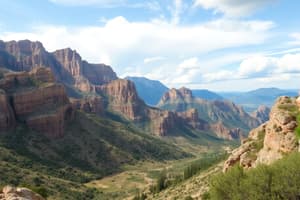Podcast
Questions and Answers
What does geophysics primarily focus on?
What does geophysics primarily focus on?
- The study of rocks
- The study of the atmosphere
- The study of crystalline materials
- The structure, physical conditions, and evolutionary history of the earth (correct)
Petrology is the study of the Earth as a whole, including its structure and history.
Petrology is the study of the Earth as a whole, including its structure and history.
False (B)
What type of materials does the section on geophysics focus on?
What type of materials does the section on geophysics focus on?
crystalline materials
The scientific study of rocks is known as ______.
The scientific study of rocks is known as ______.
Match the following terms with their respective definitions:
Match the following terms with their respective definitions:
Which of the following is a landform created by geological processes?
Which of the following is a landform created by geological processes?
Physical weathering changes the chemical composition of rocks.
Physical weathering changes the chemical composition of rocks.
Name one type of landform that is mentioned in the provided content.
Name one type of landform that is mentioned in the provided content.
The breakdown of rocks without changing their composition is known as ______ weathering.
The breakdown of rocks without changing their composition is known as ______ weathering.
Match the landform to their description
Match the landform to their description
What is a direct consequence of stress building when plates get stuck?
What is a direct consequence of stress building when plates get stuck?
Weathering has only negative impacts on the environment.
Weathering has only negative impacts on the environment.
What is one positive impact of weathering?
What is one positive impact of weathering?
When plates get stuck, _______ builds up, leading to the formations of faults.
When plates get stuck, _______ builds up, leading to the formations of faults.
Match the term with its description
Match the term with its description
What is primarily responsible for the development of unique landscapes?
What is primarily responsible for the development of unique landscapes?
Ecosystems are the main drivers of landform development.
Ecosystems are the main drivers of landform development.
What geological theory describes the process of landform development?
What geological theory describes the process of landform development?
The Plate Tectonics Theory explains how ________ create unique landscapes.
The Plate Tectonics Theory explains how ________ create unique landscapes.
Match the following items with their related description:
Match the following items with their related description:
Which of the following processes is NOT involved in breaking down solid rock?
Which of the following processes is NOT involved in breaking down solid rock?
A reservoir is a type of natural body of water that is usually formed by geological activity
A reservoir is a type of natural body of water that is usually formed by geological activity
What percentage of the Earth's surface is covered by oceans?
What percentage of the Earth's surface is covered by oceans?
The process by which wind picks up and carries away small, loose fragments of rock is known as __________ .
The process by which wind picks up and carries away small, loose fragments of rock is known as __________ .
Match the following bodies of water with their descriptions:
Match the following bodies of water with their descriptions:
What can waves and tides do to sand?
What can waves and tides do to sand?
Tectonic motions can create depressions that may become filled with water.
Tectonic motions can create depressions that may become filled with water.
What body of water is formed behind a barrier of sand?
What body of water is formed behind a barrier of sand?
A sand barrier can form by waves and tides, which ______ water behind it.
A sand barrier can form by waves and tides, which ______ water behind it.
Flashcards
Petrology
Petrology
The study of rocks and their formation, composition, and history.
Crystalline Materials
Crystalline Materials
Crystalline materials are solids with a highly ordered, repeating arrangement of atoms or molecules.
Physical Conditions
Physical Conditions
The physical conditions of the Earth, like temperature, pressure, and chemical composition, influence the formation and evolution of rocks.
Geophysics
Geophysics
Geophysics is the study of Earth's physical properties and processes.
Signup and view all the flashcards
Evolutionary History of Earth
Evolutionary History of Earth
The evolutionary history of Earth refers to the major changes and events that have shaped our planet throughout its history.
Signup and view all the flashcards
Physical Weathering
Physical Weathering
The process of breaking down rocks through physical forces.
Signup and view all the flashcards
Chemical Weathering
Chemical Weathering
The process of breaking down rocks by changing their chemical composition.
Signup and view all the flashcards
Plateau
Plateau
A large, flat area of land that stands high above the surrounding land.
Signup and view all the flashcards
Canyon
Canyon
A deep, narrow valley with steep sides, often carved by a river.
Signup and view all the flashcards
Mountain
Mountain
A large, elevated area of land with steep slopes.
Signup and view all the flashcards
Weathering
Weathering
The breakdown of rocks, soil, and minerals through contact with the Earth's atmosphere, water, and biological organisms.
Signup and view all the flashcards
Positive Impacts of Weathering
Positive Impacts of Weathering
Positive effects of weathering on the environment, such as creating fertile soil and enhancing biodiversity.
Signup and view all the flashcards
Stress in Tectonic Plates
Stress in Tectonic Plates
The force that builds up when tectonic plates get stuck and cannot move easily.
Signup and view all the flashcards
Faults
Faults
Cracks in the Earth's crust caused by the buildup of stress from tectonic plate movement.
Signup and view all the flashcards
Fault Formation
Fault Formation
Faults form when rocks are subjected to stress from tectonic plate movement, causing them to break.
Signup and view all the flashcards
Landform Development
Landform Development
The process of creating unique landscapes through natural forces like erosion and deposition.
Signup and view all the flashcards
Plate Tectonics Theory
Plate Tectonics Theory
A theory explaining the movement of Earth's tectonic plates and their impact on the Earth's surface.
Signup and view all the flashcards
Landforms
Landforms
The unique landscapes formed due to geological processes, such as mountain ranges, valleys, and plateaus.
Signup and view all the flashcards
Rock Cycle
Rock Cycle
The process of creating and transforming rocks, influenced by factors like temperature, pressure, and chemical composition.
Signup and view all the flashcards
Deflation
Deflation
The process of wind removing loose particles from the ground, leaving behind depressions and hollows.
Signup and view all the flashcards
Wind Abrasion
Wind Abrasion
The process of wind-driven sand particles striking and grinding against rock surfaces, causing them to wear down and become smooth.
Signup and view all the flashcards
Attrition by Wind
Attrition by Wind
The process of wind-blown particles colliding with each other, causing them to break down into smaller, rounder fragments.
Signup and view all the flashcards
Ocean
Ocean
A large body of salt water that covers approximately 71% of the Earth's surface.
Signup and view all the flashcards
Sea
Sea
A large body of saline water that is usually smaller and shallower than an ocean, often partially enclosed by land.
Signup and view all the flashcards
Tectonic Island
Tectonic Island
A type of island formed by tectonic activity, often with a lagoon in the center.
Signup and view all the flashcards
Lagoon
Lagoon
A body of water that is partially or completely enclosed by land, often formed by a barrier island.
Signup and view all the flashcards
Barrier Island
Barrier Island
A long, narrow strip of land that runs parallel to the coast, often formed by the accumulation of sand.
Signup and view all the flashcards
Wave and Tide Action
Wave and Tide Action
The process of waves and tides eroding the coastline and depositing sand, forming landforms like barrier islands.
Signup and view all the flashcards
Depressions Filled With Water
Depressions Filled With Water
Depressions in the land that were created by tectonic motions and later filled with water, forming lagoons.
Signup and view all the flashcardsStudy Notes
Introduction to Geology
- Geology is the study of the origin, occurrence, distribution, and usage of materials (metallic, non-metallic, inorganic), minerals, rocks, sediments, soils, water, oil, and other inorganic natural resources.
Branches of Geology
- Structural Geology: Focuses on the configuration of rocks within the Earth's crust.
- Geomorphology: Studies the formation and evolution of landforms and bathymetric features.
- Crystallography: Examines the external forms and internal atomic structure of crystalline materials.
- Petrology: Studies rocks, including their composition, texture, structure, occurrence, distribution, and origin.
- Stratigraphy: Describes and classifies sedimentary rock layers and interprets their environments of formation.
- Paleontology: The study of fossils and how they can provide information on past organisms and environments.
- Hydrogeology: Focuses on the distribution, movement, and occurrence of groundwater within the Earth's crust.
- Seismology: Studies the Earth's structure through seismic waves, and surface deformations during earthquakes.
- Geochemistry: Studies the chemical composition of the Earth's crust and oceans.
- Mining Geology: Applies geological knowledge to develop mineral resources.
- Spectral Geology: Measures and analyzes the electromagnetic spectrum to identify rock types.
- Marine Surveying: Investigates the ocean floor's processes and features.
- Mineralogy: Studies the characteristics of minerals.
- Geophysics: Examines the Earth's physical structure, conditions, and evolution.
- Physical Geology: Focuses on geological processes that create landforms and change Earth's surface.
- Engineering Geology: Applies geological knowledge to civil engineering.
- Geodesy: Studies Earth's shapes and dimensions.
- Historical Geology: Reconstructs past geological history
- Oceanography: Studies the composition, motion, and processes responsible for ocean water.
- Sedimentology: Studies sediment grains to understand their formation and distribution.
Compositional Layers of the Earth
- Crust: The outermost rocky layer (0-100 km).
- Mantle: Layer between crust and outer core (100-2900 km).
- Core: Innermost layer (2900-6370 km).
Mechanical Layers of the Earth
- Lithosphere: The rigid outer layer, made of the crust and upper mantle.
- Asthenosphere: The soft, plastic layer of the mantle that allows tectonic plates to move.
- Mesosphere: The strong, lower part of the mantle.
- Outer Core: A liquid layer composed of iron and nickel.
- Inner Core: A solid sphere of iron and nickel.
Plate Tectonics
- Plate tectonics is the theory that Earth's lithosphere is divided into plates that move constantly, causing earthquakes and creating mountain ranges, volcanoes, and continents.
- Boundaries: Divergent, convergent (ocean-ocean, ocean-continent, continent-continent), and transform.
Weathering
- Weathering is the breakdown of rocks into smaller pieces.
- Includes physical weathering (e.g., frost wedging, thermal expansion) and chemical weathering (e.g., dissolution, oxidation).
Erosion
- Erosion is the transportation of weathered material by natural forces (wind, water, ice).
- Erosion is directly related to weathering and deposition.
Geological Works of Wind
- Wind can erode, transport, and deposit sediment.
- Methods include deflation, abrasion, and attrition.
Geological Works of Water
- Water can erode, transport, and deposit sediment.
- Includes erosion by rivers, waves, glaciers, and oceans.
Geological Works of Lakes
- Lakes are accumulations of water that are characterized by many variables (depth, shape, water quality elements)
- Lakes are caused by glacial activity, tectonic movements, meteorite hits, and river courses.
Geological Works of Oceans
- The ocean influences Earth's climate through currents and wind patterns.
- The ocean acts as a major reservoir for water and nutrients.
Studying That Suits You
Use AI to generate personalized quizzes and flashcards to suit your learning preferences.




